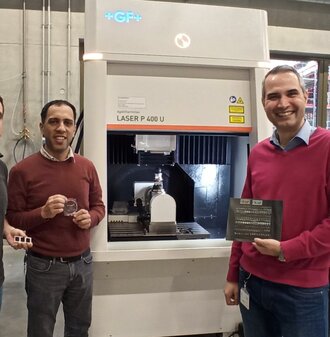
Institute for Precision Machining sets new standards in laser technology
It's all a question of surface. Do you want a material to repel liquids, or should they adhere well? Should light be reflected or not? It sounds a bit like "Make a wish!" but at the Institute for Precision Machining (KSF) in Tuttlingen, there is a system that can do all this, and much more. The rather inconspicuous "cabinet" is worth €1.2 million, and KSF director Prof. Dr.-Ing. Bahman Azarhoushang is justifiably proud of this unique equipment in his laboratory, stating, "I don't think there is another facility in Europe that can do all this."
For the past year and a half, "GF-P400U - Femto Flexipulse" has been giving the team at KSF one first after another. The secret is an ultrashort pulse laser that is moved by five mechanical axes, setting new standards in surface technology. Azarhoushang shows a pair of scissors and a needle holder - typical examples, because after all Tuttlingen is a world centre of medical technology. "Here we have created a superhydrophobic surface," the lab manager explains. "In just a few seconds, the laser processes the tools so that no water or blood sticks to them. This is a huge advantage for a surgeon, who can now see much better in the operating area, " Azarhoushang says.
Still on the subject of medical technology, "GF-P400U" also does amazing things with implants. If the surface of a bone implant is treated with a laser, the body's own bone can grow onto the artificial parts many times faster – "We're talking days instead of weeks," says Azarhoushang.
The ultrashort-pulse laser works with a so-called "pulse width," or speed, of pico- or femtoseconds –a quadrillionth of a second. "We use what is called 'cold ablation,'" explains Professor Azarhoushang. "This converts the material from a solid directly into gas and does it so quickly that there are no reciprocal effects." The machine's five axes make it possible to machine workpieces with free forms and position them in space with micrometre precision.
Revolutionary technologies
The system is also used in "tribology optimisation" – this involves friction, wear and the necessary use of lubricants, for example in pump components. Azarhoushang and his team placed tiny concave “saucers” on the ceramic surface of a bushing, i.e., depressions that can literally hold the lubricant. The result – much less lubricant is needed, and the workpiece has a much longer service life than without the ingenious surface structure.
Enthusiastically, Professor Azarhoushang shows another "GF-P400U" workpiece – which this time seems more like art than technology. "With the laser, we can design hologram surfaces," he explains, "Depending on how much light there is, you see the surface in a different colour because the light is refracted differently. Such a surface is one hundred percent tamper-proof, for example!"
Another project which deals with optics is a research project Azarhoushang will launch next year. This time, he is embarking on a quest for absolute black. "We'll be working on an anti-reflective surface," he reveals. The deep black will be used inside endoscopes, where it will suppress any light reflection. In an endoscopy, i.e., a camera recording inside the body, illumination and image quality are crucial for diagnosis. Without light interference, Azarhoushang expects significantly faster and better results.
Companies do not need their own five-axis laser system to be able to mass produce the novel surfaces. In many projects, lasers have been used to create moulds, which in turn are used in normal injection moulding.
Professor Azarhoushang is currently investigating, for example, how it might be possible to transfer antimicrobial surfaces to plastics – surfaces to which germs do not adhere also have obvious uses in fields other than medical technology.
Whether maintenance- and wear-free workpieces made of super-hard, diamond-containing material for deep sea use, or ultra-thin, curved glass – apparently there is virtually no material to which "GF-P400U" cannot apply a new surface. Obviously, at KSF, you can "make a wish"!
![[Translate to English:] [Translate to English:]](https://www.hs-furtwangen.de/fileadmin/_processed_/b/1/csm_FB_FemoLaser_a1d2e3e47f.jpg)